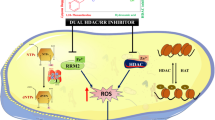Abstract
Histone deacetylase (HDAC), a key regulator in controlling the acetylation status of histone, are considered to be associated with viability, migration, invasion, proliferation and apoptosis of malignant tumors. The HDAC inhibition is an effective strategy for designing compounds against malignant tumors and five compounds have been approved by FDA or NMPA for clinical therapy. In this study, we designed and synthesized a series of novel carbazole-hydroxamate analogues as HDAC inhibitors and evaluated their anti-tumor properties in vitro. Compared with vorinostat, the HDAC semi-inhibitory concentration of compounds 3f and 3g decreased 4–13 folds, compounds 8a and 8c also showed strong inhibitory HDAC activity, and compound 3g had a strong inhibitory effect on HDAC 1. The CCK8 assay showed that compounds 3g displayed good antiproliferative activity on tested tumor cells. Flow cytometric and western blot assay showed that 3g exerted anti-tumor activities by regulating the level of Ac-HH3 and activating the cleaved caspase 3. Based on these results, carbazole-hydroxamate derivative 3g might become a potential anti-tumor candidate molecule to further structural optimization research.
Graphical Abstract







Similar content being viewed by others
References
Khan O, La Thangue NB. HDAC inhibitors in cancer biology: emerging mechanisms and clinical applications. Immunol Cell Biol. 2012;90:85–94. https://doi.org/10.1038/icb.2011.100.
Bajbouj K, Al-Ali A, Ramakrishnan RK, Saber-Ayad M, Hamid Q. Histone modification in NSCLC: molecular mechanisms and therapeutic targets. Int J Mol Sci. 2021;22:11701 https://doi.org/10.3390/ijms222111701.
Kunadis E, Lakiotaki E, Korkolopoulou P, Piperi C. Targeting post-translational histone modifying enzymes in glioblastoma. Pharmacol Ther. 2021;220:107721 https://doi.org/10.1016/j.pharmthera.2020.107721.
Abu-Zhayia ER, Machour FE, Ayoub N. HDAC-dependent decrease in histone crotonylation during DNA damage. J Mol Cell Biol. 2019;11:804–6. https://doi.org/10.1093/jmcb/mjz019.
Liang T, Zhou Y, Elhassan RM, Hou X, Yang X, Fang H. HDAC–Bax multiple ligands enhance Bax-dependent apoptosis in Hela cells. J Med Chem. 2020;63:12083–99. https://doi.org/10.1021/acs.jmedchem.0c01454.
Punpai S, Saenkham A, Jarintanan F, Jongrungruangchok S, Choowongkomon K, Suksamrarn S, et al. HDAC inhibitor cowanin extracted from G. fusca induces apoptosis and autophagy via inhibition of the PI3K/Akt/mTOR pathways in Jurkat cells. Biomed Pharmacother. 2022;147:112577 https://doi.org/10.1016/j.biopha.2021.112577.
Cui H, Hong Q, Wei R, Li H, Wan C, Chen X, et al. Design and synthesis of HDAC inhibitors to enhance the therapeutic effect of diffuse large B-cell lymphoma by improving metabolic stability and pharmacokinetic characteristics. Eur J Med Chem. 2022;229:114049 https://doi.org/10.1016/j.ejmech.2021.114049.
Liu M, Gao S, Liang T, Qiu X, Yang X, Fang H, et al. Discovery of novel Src homology-2 domain-containing phosphatase 2 and histone deacetylase dual inhibitors with potent antitumor efficacy and enhanced antitumor immunity. J Med Chem. 2022;65:12200–18. https://doi.org/10.1021/acs.jmedchem.2c00866.
Vaidya GN, Rana P, Venkatesh A, Chatterjee DR, Contractor D, Satpute DP, et al. Paradigm shift of “classical” HDAC inhibitors to “hybrid” HDAC inhibitors in therapeutic interventions. Eur J Med Chem. 2021;209:112844 https://doi.org/10.1016/j.ejmech.2020.112844.
Hesham HM, Lasheen DS, Abouzid KAM. Chimeric HDAC inhibitors: comprehensive review on the HDAC-based strategies developed to combat cancer. Med Res Rev. 2018;38:2058–109. https://doi.org/10.1002/med.21505.
Huang L, Feng Z-L, Wang Y-T, Lin L-G. Anticancer carbazole alkaloids and coumarins from Clausena plants: a review. Chin J Nat Med. 2017;15:881–8. https://doi.org/10.1016/S1875-5364(18)30003-7.
Głuszyńska A. Biological potential of carbazole derivatives. Eur J Med Chem. 2015;94:405–26. https://doi.org/10.1016/j.ejmech.2015.02.059.
Humphries PS, Bersot R, Kincaid J, Mabery E, McCluskie K, Park T, et al. Carbazole-containing amides and ureas: discovery of cryptochrome modulators as antihyperglycemic agents. Bioorg Med Chem Lett. 2018;28:293–7. https://doi.org/10.1016/j.bmcl.2017.12.051.
Chen C, Chu H, Wang A, Yin H, Gao Y, Liu S, et al. Discovery of 2,5-diphenyl-1,3,4-thiadiazole derivatives as HDAC inhibitors with DNA binding affinity. Eur J Med Chem. 2022;241:114634 https://doi.org/10.1016/j.ejmech.2022.114634.
Chen C, Hou X, Wang G, Pan W, Yang X, Zhang Y, et al. Design, synthesis and biological evaluation of quinoline derivatives as HDAC class I inhibitors. Eur J Med Chem. 2017;133:11–23. https://doi.org/10.1016/j.ejmech.2017.03.064.
Chen C, Li X, Zhao H, Liu M, Du J, Zhang J, et al. Discovery of DNA-targeting HDAC inhibitors with potent antitumor efficacy in vivo that trigger antitumor immunity. J Med Chem. 2022;65:3667–83. https://doi.org/10.1021/acs.jmedchem.1c02225.
Velasco D, Castellanos S, López M, López-Calahorra F, Brillas E, Juliá L. Red organic light-emitting radical adducts of carbazole and tris(2,4,6-trichlorotriphenyl)methyl radical that exhibit high thermal stability and electrochemical amphotericity. J Org Chem. 2007;72:7523–32. https://doi.org/10.1021/jo0708846.
Funding
This work was supported by the Key Research and Development Program of Shandong Province (No. 2019JZZY011115 and 2021CXGC011101), Weihai Zhengsheng Biotechnology Foundation and Rongxiang Regenerative Medicine Foundation of Shandong University (No. 2019SDRX-05), National Natural Science Foundation of China (22101146), Natural Science Foundation of Shandong Province (ZR2020QB005), Weihai-Shandong Academy of Sciences Industry University research collaborative innovation fund (2020CXY08, 2020GC04).
Author information
Authors and Affiliations
Corresponding authors
Ethics declarations
Conflict of interest
The authors declare no competing interests.
Additional information
Publisher’s note Springer Nature remains neutral with regard to jurisdictional claims in published maps and institutional affiliations.
Supplementary Information
Rights and permissions
Springer Nature or its licensor (e.g. a society or other partner) holds exclusive rights to this article under a publishing agreement with the author(s) or other rightsholder(s); author self-archiving of the accepted manuscript version of this article is solely governed by the terms of such publishing agreement and applicable law.
About this article
Cite this article
Sun, L., Han, L., Zhang, L. et al. Design, synthesis, and antitumor activity evaluation of carbazole derivatives with potent HDAC inhibitory activity. Med Chem Res 32, 1677–1689 (2023). https://doi.org/10.1007/s00044-023-03084-0
Received:
Accepted:
Published:
Issue Date:
DOI: https://doi.org/10.1007/s00044-023-03084-0




